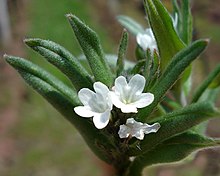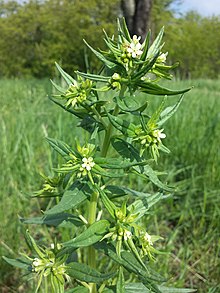Nome comune: erba perla minore, erba perla bianca
Specie: Buglossoides arvensis (L.) I.M. Johnst. [Lithospermum arvense L.]
Famiglia: BORAGINACEAE
È una pianta annuale, alta fino a 50 cm, molto ramosa. Il termine generico richiama la somiglianza delle foglie alla lingua dei bovini (per la ruvidezza al tatto). Fiorisce dall’inverno sino agli inizi dell’estate.
- I fiori sono piccoli di colore bianco, bianco-giallastro, raramente purpureo, con corolla che di solito non supera i 5 mm, e asse fiorale allungato.
- Le foglie, frequentemente ruvide al tatto, sono generalmente erette e aderenti ai fusti, di forma lineare-spatolata.
- I fusti sono ramosi in alto, ruvidi al tatto per la presenza di fitti peli da ricurvi a eretto-appressati.
Si tratta di una specie officinale; in passato le foglie erano utilizzate in infuso come diuretico.
Galleria
 Link da Actaplantarum: Buglossoides arvensis
Link da Actaplantarum: Buglossoides arvensis
Contents
Lithospermum arvense
| Lithospermum arvense | |
|---|---|

| |
| Scientific classification | |
| Kingdom: | Plantae |
| Clade: | Tracheophytes |
| Clade: | Angiosperms |
| Clade: | Eudicots |
| Clade: | Asterids |
| Order: | Boraginales |
| Family: | Boraginaceae |
| Genus: | Lithospermum |
| Species: | L. arvense
|
| Binomial name | |
| Lithospermum arvense | |
| Synonyms | |
|
Buglossoides arvensis (L.) I.M.Johnst. | |
Lithospermum arvense (syn. Buglossoides arvensis), known as field gromwell, corn gromwell, bastard alkanet, and stone seed, is a flowering plant of the family Boraginaceae. It is native to Europe and Asia, as far north as Korea, Japan and Russia, and as far south as Afghanistan and northern Pakistan. [1] It is known in other places as an introduced species, including much of North America and Australia. [2],[3] The European Union has granted the refined oil of the seed of Buglossoides arvensis novel food status and some farmers are growing it [4] commercially in the United Kingdom as a plant-variety patented (PVP) and trademarked cultivar (Ahiflower®). The seed oil contains high levels (63-72%) of omega-3 ALA (c18:3), omega-3 SDA (c18:4), and omega-6 GLA (c18:3)[5] and has GRAS (generally regarded as safe) review status from the US Food and Drug Administration, Canadian ingredient master file (IMF) registration and novel food status, and GMP+ Feed Support Product status in the EU for livestock and companion animals (including for defatted expeller press cake meal). The seed oil also has TGA Australia Complementary Medicines approval status, ANVISA/MAPA Brazil human and animal alimentary use approval, and limited food use approvals in Korea and Japan.
Refined Buglossoides oil has peer-reviewed published human clinical evidence from controlled dietary intervention trials showing up to 400% more efficient omega-3 EPA (c20:5) accrual in circulating cells vs flaxseed oil [6] and has been shown to significantly upregulate the cytokine interleukin-10 (IL-10) in lipopolysaccharide (LPS) stimulated macrophages by +40% vs. control [7]. IL-10 is recognized as one of the immune modulatory signaling cytokines that moderates the inflammatory response after intensive exercise or immune challenge. Further, refined Buglossoides oil has been shown to form omega-3 DHA (C22:6) endogenously with comparable efficiency as pure marine DHA in mammals and maintain DHA levels similarly in the brain and liver. [8] It has also been shown in recent peer-reviewed research to promote live probiotic survival into the small intestine in the TIMS-1 simulated gut [9] and contribute beneficially to anti-neuroinflammation response in vitro [10] and synergistically to improved executive function and cognitive flexibility in healthy adults. [11] Based on its fatty acid composition, refined Buglossoides oil naturally provides the body a more diverse array of anti-inflammatory omega-3 and omega-6 (via GLA) substrates than derive from preformed EPA/DHA sources. These include SDA, ETA (C20:4n-3), GLA, and DGLA (C20:3n-6).
Seeds of Buglossoides have been reported in Ukrainian archeological sites dating back as far as 4000 BC where they were stored in clay pots, however the purpose and usage of the seeds has not been determined. In modern European arable agriculture, Buglossoides often appears as a weed species with poor competitive and non-invasive characteristics.
References
[1] "Lithospermum arvense Linnaeus, Sp. Pl. 1: 132. 1753". Flora of China.
[3] ^ "Buglossoides arvensis". Australian Plant Name Index (APNI), IBIS database. Centre for Plant Biodiversity Research, Australian Government, Canberra. Retrieved 20 March 2012.
[4] ^ Nosowitz, Dan (19 November 2015). "What Is This Weird Weed, and Why Are Farmers and Health Nuts So Into It?". Modern Farmer. Retrieved 30 November 2015.
[5] Cumberford G & Hebard A (2015) Ahiflower oil: A novel non-GM plant-based omega-3+6 source. J Lipid Tech Sep 28:9; 207-210. Retrieved 10 Jun 2022.
[6] Lefort (2016) Consumption of Buglossoides arvensis seed oil is safe and increases tissue long-chain n-3 fatty acid content more than flax seed oil. J Nutr Sci 5:e2, 1-12. Retrieved 10 Jun 2022.
[7] Lefort (2017) Dietary Buglossoides arvensis oil increases circulating n-3 polyunsaturated fatty acids in a dose-dependent manner and enhances lipopolysaccharide-stimulated whole blood interleukin-10—a randomized placebo-controlled trial. Nutrients 9:261; 1-17. Retrieved 10 Jun 2022.
[8] Metherel A (2021) Determining plasma and tissue DHA turnover from Ahiflower® oil, flaxseed oil and DHA using compound specific isotopic analysis. J Am Oil Chem Soc 2021;98(Suppl. 1):242–243.
[9] Venema K et al. (2020) Survival of a probiotic-containing product using capsule-within-capsule technology in an in vitro model of the stomach and small intestine (TIM-1). Beneficial Microbes 2020; 11(4): 403-409
[10] Cumberford G et al (2023) Methods and compositions with purified Bombyx morii cocoon silk fiber and refined Buglossoides arvensis seed oil providing anti-inflammatory effects and neuroprotection for disease states. Patent #US 11707497B2 (July 25, 2023), p. 101.
[11] Lanou A (2023) A randomized, placebo-controlled clinical trial of a novel dietary supplement (Braini) on standardized CNS vital signs cognitive performance parameters in adults. J Integr Complement Med. 2023; May;29(5):303-312.
External links
Lithospermum
Lithospermum L. è un genere di piante perenni della famiglia delle Boraginacee.[1]
Descrizione
I fiori, a volte , sono portati in cime fogliose terminali o ascellari.
Il calice pentalobato più o meno fino alla base è accrescente.
La corolla può variare da cilindrica a infundibuliforme, è biancastra e ha un tubo con 5 squame più o meno glandulose alla fauce e con un anello alla base.
Gli stami sono inclusi e inseriti a circa la metà del tubo.
Lo stilo, semplice, è incluso e ha stimma bilobo.
Le nucule, lisce, bianche e lucenti, sono quattro e completamente staccate dal ricettacolo.
Distribuzione e habitat
Il genere è presente in Europa, Africa, Asia, Nord America e Sud America[1]. In Italia è presente una sola specie, [2].
Tassonomia
Il genere comprende 84 specie:[1]
- DC.
- Weim.
- (G.L.Nesom) J.I.Cohen
- Pat.-Sicil., Cohen & Pérez-Calix
- Pat.-Sicil., Cohen & Pérez-Calix
- Weigend & Nürk
- (I.M.Johnst.) J.I.Cohen
- I.M.Johnst.
- Weigend & Nürk
- B.L.Rob.
- A.Gray
- (J.F.Macbr.) I.M.Johnst.
- (Michx.) Lehm.
- (J.F.Gmel.) MacMill.
- J.I.Cohen
- J.I.Cohen
- (A.DC.) I.M.Johnst.
- DC.
- Greene
- I.M.Johnst.
- (B.L.Turner) J.I.Cohen
- Pers.
- Weigend & Nürk
- (J.R.Allison) Weakley
- M.Martens & Galeotti
- Ortega
- DC.
- (I.M.Johnst.) J.I.Cohen
- Pat.-Sicil., J.I.Cohen & Zamudio
- Siebold & Zucc.
- (D.Don) J.I.Cohen
- Sessé & Moc.
- Lehm.
- (Wedd.) I.M.Johnst.
- Donn.Sm.
- Oliv.
- (Small) J.I.Cohen
- E.Mey. ex DC.
- Lehm.
- I.M.Johnst.
- Pat.-Sicil., J.I.Cohen & Zamudio
- I.M.Johnst.
- J.I.Cohen
- J.I.Cohen
- Michx.
- (I.M.Johnst.) J.I.Cohen
- Weigend & Nürk
- I.M.Johnst.
- J.I.Cohen
- DC.
- I.M.Johnst.
- Small
- (Michx.) Muhl.
- I.M.Johnst.
- Torr. ex A.Gray
- Greenm.
- (I.M.Johnst.) J.I.Cohen
- (B.L.Turner) J.I.Cohen
- Greenm.
- J.F.Macbr.
- (Mack.) Weakley
- L.
- Thunb.
- Weakley, Witsell & D.Estes
- DC.
- (I.M.Johnst.) J.I.Cohen
- I.M.Johnst.
- B.L.Rob.
- Weigend & Nürk
- (I.M.Johnst.) J.I.Cohen
- Douglas ex Lehm.
- J.I.Cohen
- Thunb.
- Lehm.
- (Mack. & Bush) Weakley
- J.I.Cohen & J.C.Manning
- J.I.Cohen
- (Lehm.) J.I.Cohen
- Rugel ex DC.
- Greene
- J.I.Cohen
- (J.F.Macbr.) J.I.Cohen
- L.
- Greene
Note
- ^ a b c (EN) Lithospermum, in Plants of the World Online, Board of Trustees of the Royal Botanic Gardens, Kew. URL consultato il 28 gennaio 2024.
- ^ Pignatti S., Lithospermum, in Flora d'Italia Vol. III, Milano, Edagricole, 2017, pp. 140-141, ISBN 9788850652440.
Bibliografia
- Sandro Pignatti, Flora d'Italia, Edagricole, Bologna 1982. ISBN 88-506-2449-2
- T.G. Tutin, V.H. Heywood et Alii, Flora Europea, Cambridge University Press 1976. ISBN 0-521-08489-X
Altri progetti
 Wikimedia Commons contiene immagini o altri file su Lithospermum
Wikimedia Commons contiene immagini o altri file su Lithospermum Wikispecies contiene informazioni su Lithospermum
Wikispecies contiene informazioni su Lithospermum
Collegamenti esterni
| Controllo di autorità | J9U (EN, HE) 987007532164005171 |
|---|


![Lithospermum arvense [da wikimedia, tavola tratta da, original book source: Prof. Dr. Otto Wilhelm Thomé Flora von Deutschland, Österreich und der Schweiz 1885, Gera, Germany pubblico dominio]](https://www.treviambiente.it/ambienteebiodiversita/wp-content/uploads/sites/9/2017/08/Illustration_Lithospermum_arvense0-tavola-wikimedia-560x560.jpg)
![Buglossoides arvensis [via pixabay CC0 Creative Commons]](https://www.treviambiente.it/ambienteebiodiversita/wp-content/uploads/sites/9/2017/08/buglossoides-arvensis-846513_1280-via-pixabay-560x560.jpg)



